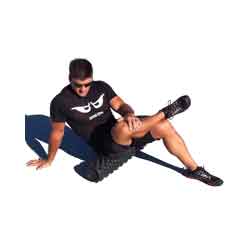 This SMR exercise is a variation of the Piriformis Press technique to address the lateral rotators of the hip. You may find this exercise easier. If the Piriformis Press is too intense to work with, then practice the Piriformis Roll to more gently work out the "junk" in your buns. It may take a month or two to help your muscles along to become healthy enough to handle the Secondary technique (which is the preferred standard SMR technique for the piriformis). You probably won't notice knots in your buns when you are just walking around, but you may have a deep ache in one or more of the other muscles "back there." The gluteus maximus (and the other posterior hip muscles) is involved in any movement using the hips. When parts of it lock up, proper hip function is compromised. You will notice a 'lightness' with body movements if you release any knots in your glutes. |
|
For written instructions, click here to download a printable PDF of the Piriformis Roll Be sure to post your questions and comments below. We want to provide the best instruction to help you recover from your workouts. Click here to return to all of the Fundamental SMR Techniques **All information is provided for educational purposes only. You should consult your doctor before attempting any exercises you read on this page or any page on this website.** |
Tag: Piriformis Issues
Gluteus Medius
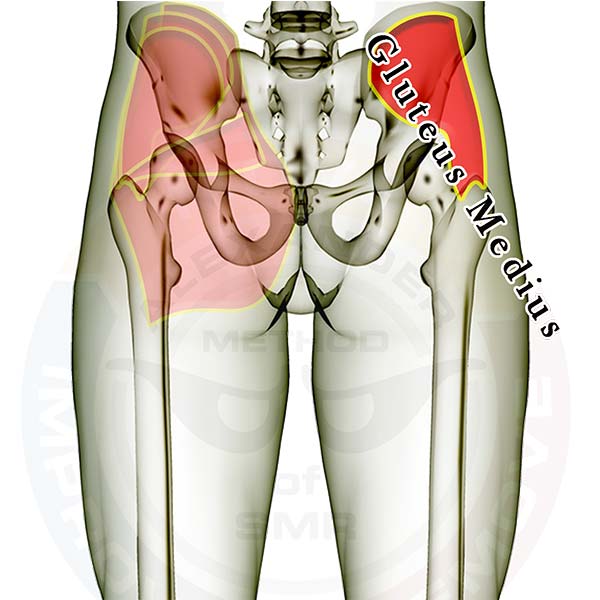
Pictured above is the gluteus medius muscle. It primarily works to extend (open) the hip, and is especially involved in stabilizing the hip when standing on one leg. It is very likely that this muscle will need stretching and SMR attention, so address it often.
The muscles are layered, showing how some of the muscles are covered by the others. All of the muscles are see-through so that you can appreciate the location and size of each muscle relative to the others.
Individual hip, lower back & thigh muscles you might be interested in: (any inactive links will be live soon)
Click here for a list of all the muscles.
Muscle that crosses the hip/lower back joint and crosses the hip/thigh joint (attaches to the spine and the femur)
Muscles that attach to the hip and the spine and/or ribs
- Rectus Abdominus
- External Abdominal Oblique
- Internal Abdominal Oblique
- Transverse Abdominus
- Latissimus Dorsi
- Iliocostalis Lumborum
- Longissimus Thoracis
- Quadratus Lumborum
- Multifidi
Muscles that attach to the hip and the thigh bone (femur)
- Iliacus
- Rectus Femoris
- Tensor Fasciae Latae
- Sartorius
- Gracilis
- Adductor Magnus
- Adductor Longus
- Adductor Brevis
- Pectineus
- Gluteus Maximus
- Gluteus Medius
- Gluteus Minimus
- Piriformis
- Superior Gemellus
- Obturator Internus
- Inferior Gemellus
- Obturator Externus
- Quadratus Femoris
- Biceps Femoris
- Semitendonosis
- Semimembranosis
Good luck working out those tight knots.
If you have any questions, please post a comment. We try to respond within 24 hours.
We're here to help you get more out of your training!
Pectineus
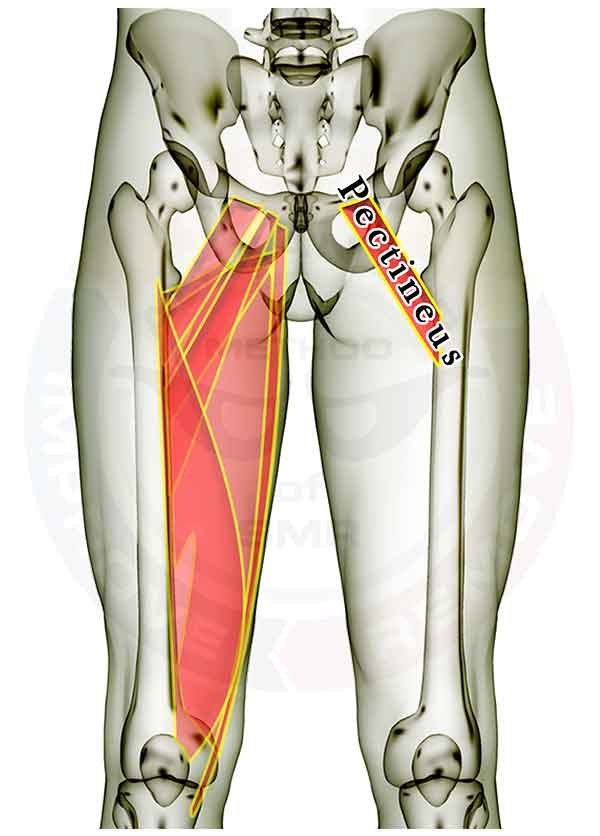
Pictured above is the pectineus muscle. It is nick-named the "4th adductor" muscle and it pulls the thigh toward the pubic bone. When this muscle is overly tight (and this is true for many of us), you will have trouble comfortably opening your legs really wide. This leads to compromised leg positioning for some functional movements such as the deep squat.
The muscles are layered, showing how some of the muscles are covered by the others. All of the muscles are see-through so that you can appreciate the location and size of each muscle relative to the others.
Individual hip, lower back & thigh muscles you might be interested in: (any inactive links will be live soon)
Click here for a list of all the muscles.
Click here to see the hip flexor muscles as a group.
Muscle that crosses the hip/lower back joint and crosses the hip/thigh joint (attaches to the spine and the femur)
Muscles that attach to the hip and the thigh bone (femur)
- Iliacus
- Rectus Femoris
- Tensor Fasciae Latae
- Sartorius
- Gracilis
- Adductor Magnus
- Adductor Longus
- Adductor Brevis
- Pectineus
- Gluteus Maximus
- Gluteus Medius
- Gluteus Minimus
- Piriformis
- Superior Gemellus
- Obturator Internus
- Inferior Gemellus
- Obturator Externus
- Quadratus Femoris
- Biceps Femoris
- Semitendonosis
- Semimembranosis
Good luck working out those tight knots.
If you have any questions, please post a comment. We try to respond within 24 hours.
We're here to help you get more out of your training!
Gracilis

Pictured above is the gracilis muscle. It runs from your pubic bone to just below your knee on the inside of your leg. It primarily works as a stabilizer for the leg on the hip joint and pulls the leg inward. When this muscle is overly tight (and this is true for many of us), you will have trouble comfortably opening your legs really wide. This leads to compromised leg positioning for some functional movements such as the deep squat.
The muscles are layered, showing how some of the muscles are covered by the others. All of the muscles are see-through so that you can appreciate the location and size of each muscle relative to the others. You can access individual muscle detail for all the other muscles in the body with our Coach membership.
Individual hip, lower back & thigh muscles you might be interested in: (any inactive links will be live soon)
Click here for a list of all the muscles.
Click here to see the hip flexor muscles as a group.
Muscle that crosses the hip/lower back joint and crosses the hip/thigh joint (attaches to the spine and the femur)
Muscles that attach to the hip and the thigh bone (femur)
- Iliacus
- Rectus Femoris
- Tensor Fasciae Latae
- Sartorius
- Gracilis
- Adductor Magnus
- Adductor Longus
- Adductor Brevis
- Pectineus
- Gluteus Maximus
- Gluteus Medius
- Gluteus Minimus
- Piriformis
- Superior Gemellus
- Obturator Internus
- Inferior Gemellus
- Obturator Externus
- Quadratus Femoris
- Biceps Femoris
- Semitendonosis
- Semimembranosis
Good luck working out those tight knots.
If you have any questions, please post a comment. We try to respond within 24 hours.
We're here to help you get more out of your training!
Iliacus
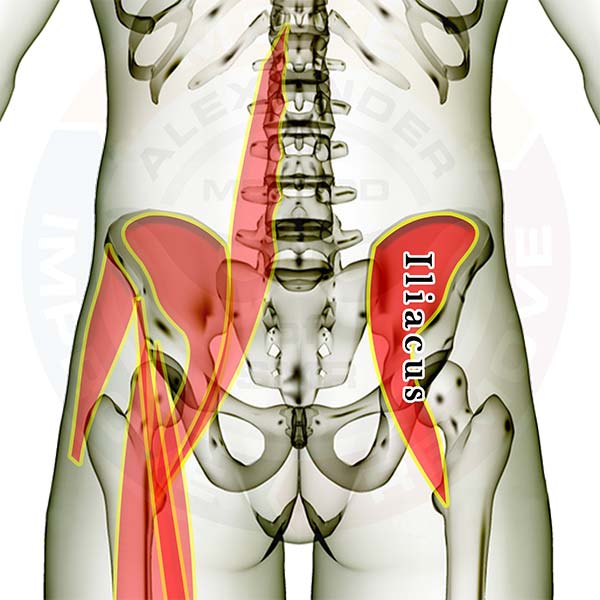
Pictured above is the iliacus. It is one of the hip flexor muscles, and pulls your leg up toward your hip (like when you lift your leg). It is one of the most influential muscle in the body. You can't move your hip in any direction without using this muscle. This muscle is VERY LIKELY to need some SMR attention along with the psoas muscle. 80% of all adults over 18 years of age have some form of back pain. If you aren't checking the psoas for excessive tension you are missing one of the most significant links to proper back function.
The muscles are layered, showing how some of the muscles are covered by the others. All of the muscles are see-through so that you can appreciate the location and size of each muscle relative to the others.
Individual hip, lower back & thigh muscles you might be interested in: (any inactive links will be live soon)
Click here for a list of all the muscles.
Click here to see the hip flexor muscles as a group.
Muscle that crosses the hip/lower back joint and crosses the hip/thigh joint (attaches to the spine and the femur)
Muscles that attach to the hip and the spine and/or ribs
- Rectus Abdominus
- External Abdominal Oblique
- Internal Abdominal Oblique
- Transverse Abdominus
- Latissimus Dorsi
- Iliocostalis Lumborum
- Longissimus Thoracis
- Quadratus Lumborum
- Multifidi
Muscles that attach to the hip and the thigh bone (femur)
- Iliacus
- Rectus Femoris
- Tensor Fasciae Latae
- Sartorius
- Gracilis
- Adductor Magnus
- Adductor Longus
- Adductor Brevis
- Pectineus
- Gluteus Maximus
- Gluteus Medius
- Gluteus Minimus
- Piriformis
- Superior Gemellus
- Obturator Internus
- Inferior Gemellus
- Obturator Externus
- Quadratus Femoris
- Biceps Femoris
- Semitendonosis
- Semimembranosis
Good luck working out those tight knots.
If you have any questions, please post a comment. We try to respond within 24 hours.
We're here to help you get more out of your training!
Piriformis
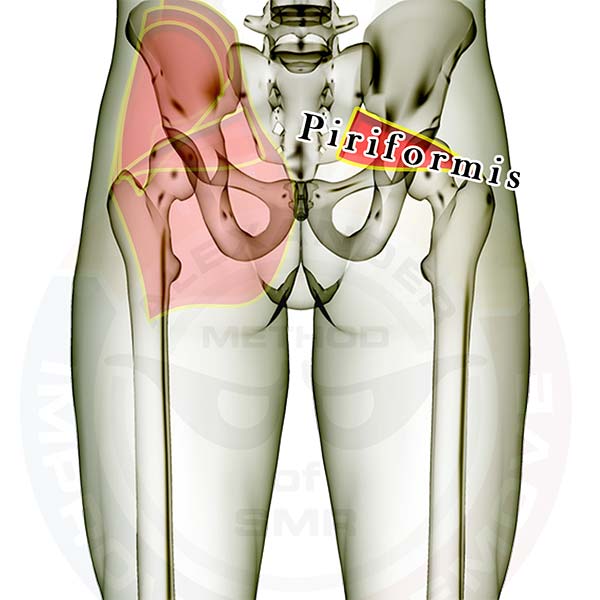
Pictured above is the piriformis. It is one of the lateral rotator muscles of the hip, and rotates your leg so that your toes point outward. Because of the location of this muscle in relation to the sciatic nerve, releasing excessive tension in this muscle can dramatically improve sciatica symptoms. (click here for a list of all the muscles)
The muscles on the left are layered, showing how some of the muscles are covered by the others. All of the muscles are see-through so that you can appreciate the location and size of each muscle relative to the others.
Individual hip, lower back & thigh muscles you might be interested in: (any inactive links will be live soon)
Muscle that crosses the hip/lower back joint and crosses the hip/thigh joint (attaches to the spine and the femur)
Muscles that attach to the hip and the spine and/or ribs
- Rectus Abdominus
- External Abdominal Oblique
- Internal Abdominal Oblique
- Transverse Abdominus
- Latissimus Dorsi
- Iliocostalis Lumborum
- Longissimus Thoracis
- Quadratus Lumborum
- Multifidi
Muscles that attach to the hip and the thigh bone (femur)
- Iliacus
- Adductor Magnus
- Adductor Longus
- Adductor Brevis
- Pectineus
- Gluteus Maximus
- Gluteus Medius
- Gluteus Minimus
- Piriformis
- Superior Gemellus
- Obturator Internus
- Inferior Gemellus
- Obturator Externus
- Quadratus Femoris
Good luck working out those tight knots.
If you have any questions, please post a comment. We try to respond within 24 hours.
We're here to help you get more out of your training!
Hip Flexors
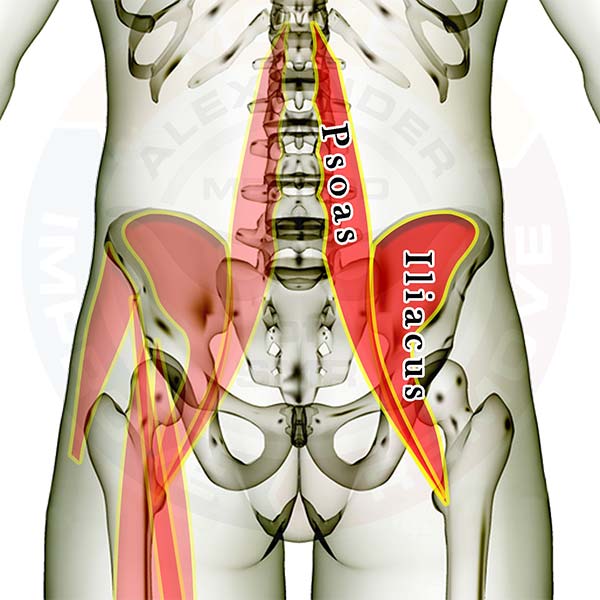
Pictured above are the hip flexor muscles. All of them pull your leg up toward your spine, and one of them pulls your spine toward your leg (like when you sit up). They are BY FAR the most influential group of muscles in the body. You can't move your hip or lower back in any direction without using one or more of these muscles. 80% of all adults over 18 years of age have some form of back pain. If you aren't checking your hip flexors for excessive tension you are missing the most significant group of muscles that contribute to proper back function.
The muscles are layered, showing how some of the muscles are covered by the others. All of the muscles are see-through so that you can appreciate the location and size of each muscle relative to the others. On the left side you can see the other muscles that are present in the same area as the hip flexors, and a couple muscles that act as mild hip flexors (Tensor Fasciae Latae & Sartorius).
Click here for a list of all the muscles.
Individual hip, lower back & thigh muscles you might be interested in: (any inactive links will be live soon)
Muscle that crosses the hip/lower back joint and crosses the hip/thigh joint (attaches to the spine and the femur)
Muscles that attach to the hip and the spine and/or ribs
- Rectus Abdominus
- External Abdominal Oblique
- Internal Abdominal Oblique
- Transverse Abdominus
- Latissimus Dorsi
- Iliocostalis Lumborum
- Longissimus Thoracis
- Quadratus Lumborum
- Multifidi
Muscles that attach to the hip and the thigh bone (femur)
- Iliacus
- Rectus Femoris
- Tensor Fasciae Latae
- Sartorius
- Gracilis
- Adductor Magnus
- Adductor Longus
- Adductor Brevis
- Pectineus
- Gluteus Maximus
- Gluteus Medius
- Gluteus Minimus
- Piriformis
- Superior Gemellus
- Obturator Internus
- Inferior Gemellus
- Obturator Externus
- Quadratus Femoris
- Biceps Femoris
- Semitendonosis
- Semimembranosis
Good luck working out those tight knots.
If you have any questions, please post a comment. We try to respond within 24 hours.
We're here to help you get more out of your training!
Adductor Magnus

Pictured above is the adductor magnus. This huge muscle on the inside of your thigh pulls your knee inward toward your hip. This muscle is too tight if your knees bow inward when you squat or during the landing of a jump. In addition, this strong muscle can act as a pseudo hamstring muscle that pulls your leg back and inward as it contracts. So a healthy adductor magnus helps LOTS of hip & thigh functions.
The leg on the left has all the muscles that cross the inside front of your thigh in addition to the adductor longus. All of the muscles in the left leg are see-through so that you can appreciate the location and size of each muscle relative to the others. You can access individual muscle detail for the quads and all the other muscles in the body with our Coach membership.
Click here for a list of all the muscles.
Click here to see the adductors as a group.
Individual muscles you might be interested in:
Muscles that attach to the thigh bone from either the spine or hip bone above (attached anywhere on the femur)
- Psoas
- Iliacus
- Rectus Femoris
- Tensor Fasciae Latae
- Sartorius
- Gracilis
- Adductor Magnus
- Adductor Longus
- Adductor Brevis
- Pectineus
- Gluteus Maximus
- Gluteus Medius
- Gluteus Minimus
- Piriformis
- Superior Gemellus
- Obturator Internus
- Inferior Gemellus
- Quadratus Femoris
- Biceps Femoris - Long Head
- Semitendonosis
- Semimembranosis
Muscles that attach to the hip and the thigh bone (femur)
- Iliacus
- Rectus Femoris
- Tensor Fasciae Latae
- Sartorius
- Gracilis
- Adductor Magnus
- Adductor Longus
- Adductor Brevis
- Pectineus
- Gluteus Maximus
- Gluteus Medius
- Gluteus Minimus
- Piriformis
- Superior Gemellus
- Obturator Internus
- Inferior Gemellus
- Quadratus Femoris
- Biceps Femoris - Long Head
- Semitendonosis
- Semimembranosis
Muscles that attach to the thigh bone (femur) and the knee cap (patella)
Muscles that cross or attach to the thigh bone (femur) and attach below the knee joint and DO NOT attach to the knee cap (patella)
- Sartorius
- Gracilis
- Semitendonosis
- Semimembranosis
- Biceps Femoris - Long Head
- Biceps Femoris - Short Head
- Gastrocnemius
- Popliteus
- Plantaris
Good luck working out those tight knots.
If you have any questions, please post a comment. We try to respond within 24 hours.
We're here to help you get more out of your training!
Adductor Longus

Pictured above is the adductor longus.
The leg on the left has all the muscles that cross the inside front of your thigh in addition to the adductor longus. All of the muscles in the left leg are see-through so that you can appreciate the location and size of each muscle relative to the others. You can access individual muscle detail for the quads and all the other muscles in the body with our Coach membership.
Click here for a list of all the muscles.
Click here to see the adductors as a group.
Individual muscles you might be interested in:
Muscles that attach to the thigh bone from either the spine or hip bone above (attached anywhere on the femur)
- Psoas
- Iliacus
- Rectus Femoris
- Tensor Fasciae Latae
- Sartorius
- Gracilis
- Adductor Magnus
- Adductor Longus
- Adductor Brevis
- Pectineus
- Gluteus Maximus
- Gluteus Medius
- Gluteus Minimus
- Piriformis
- Superior Gemellus
- Obturator Internus
- Inferior Gemellus
- Quadratus Femoris
- Biceps Femoris - Long Head
- Semitendonosis
- Semimembranosis
Muscles that attach to the hip and the thigh bone (femur)
- Iliacus
- Rectus Femoris
- Tensor Fasciae Latae
- Sartorius
- Gracilis
- Adductor Magnus
- Adductor Longus
- Adductor Brevis
- Pectineus
- Gluteus Maximus
- Gluteus Medius
- Gluteus Minimus
- Piriformis
- Superior Gemellus
- Obturator Internus
- Inferior Gemellus
- Quadratus Femoris
- Biceps Femoris - Long Head
- Semitendonosis
- Semimembranosis
Muscles that attach to the thigh bone (femur) and the knee cap (patella)
Muscles that cross or attach to the thigh bone (femur) and attach below the knee joint and DO NOT attach to the knee cap (patella)
- Sartorius
- Gracilis
- Semitendonosis
- Semimembranosis
- Biceps Femoris - Long Head
- Biceps Femoris - Short Head
- Gastrocnemius
- Popliteus
- Plantaris
Good luck working out those tight knots.
If you have any questions, please post a comment. We try to respond within 24 hours.
We're here to help you get more out of your training!
Adductor Brevis
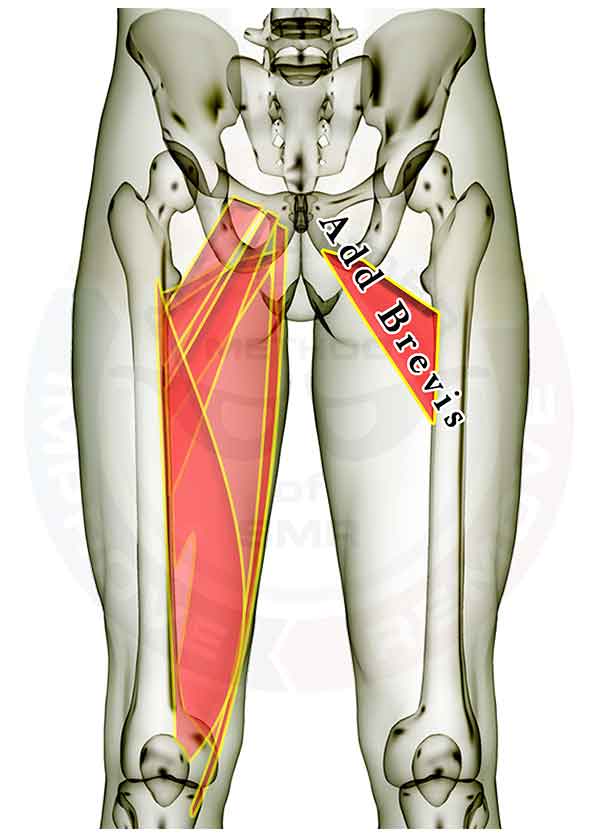
Pictured above is the adductor brevis.
The leg on the left has all the muscles that cross the inside front of your thigh in addition to the adductor brevis. All of the muscles in the left leg are see-through so that you can appreciate the location and size of each muscle relative to the others.
Click here for a list of all the muscles.
Click here to see the adductors as a group.
Individual muscles you might be interested in:
Muscles that attach to the thigh bone from either the spine or hip bone above (attached anywhere on the femur)
- Psoas
- Iliacus
- Rectus Femoris
- Tensor Fasciae Latae
- Sartorius
- Gracilis
- Adductor Magnus
- Adductor Longus
- Adductor Brevis
- Pectineus
- Gluteus Maximus
- Gluteus Medius
- Gluteus Minimus
- Piriformis
- Superior Gemellus
- Obturator Internus
- Inferior Gemellus
- Quadratus Femoris
- Biceps Femoris - Long Head
- Semitendonosis
- Semimembranosis
Muscles that attach to the hip and the thigh bone (femur)
- Iliacus
- Rectus Femoris
- Tensor Fasciae Latae
- Sartorius
- Gracilis
- Adductor Magnus
- Adductor Longus
- Adductor Brevis
- Pectineus
- Gluteus Maximus
- Gluteus Medius
- Gluteus Minimus
- Piriformis
- Superior Gemellus
- Obturator Internus
- Inferior Gemellus
- Quadratus Femoris
- Biceps Femoris - Long Head
- Semitendonosis
- Semimembranosis
Muscles that attach to the thigh bone (femur) and the knee cap (patella)
Muscles that cross or attach to the thigh bone (femur) and attach below the knee joint and DO NOT attach to the knee cap (patella)
- Sartorius
- Gracilis
- Semitendonosis
- Semimembranosis
- Biceps Femoris - Long Head
- Biceps Femoris - Short Head
- Gastrocnemius
- Popliteus
- Plantaris
Good luck working out those tight knots.
If you have any questions, please post a comment. We try to respond within 24 hours.
We're here to help you get more out of your training!
